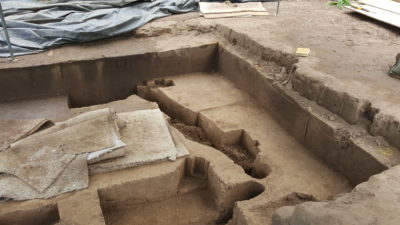Work is wrapping up this week on the latest chapter of a project to uncover an ancient civilization literally buried in a Cass County cornfield.
A large fortified village that existed from the mid-1100s for several centuries sits, waiting to be uncovered beneath the grounds of the former Lawrenz Gun Club site in the northwestern part of Cass County, just a stone’s throw from the Sangamon River.
The village was inhabited by the Mississippians, a Native American culture. Perhaps the most famous example of a similar settlement in Illinois is the Cahokia Mounds in the Metro East. But, this is thought to be the largest Mississippian village in the Illinois River Valley.
Jeremy Wilson of Indiana University-Purdue University Indianapolis has been here since 2010, when the private landowners in the area gave him the green light to find out more about the mounds site that had been known about for decades.
“Most of our work over the past six years has been within the fortified village, and we’ve been doing, really, kind of two main things- of course, the archeology that you traditionally think about- the square hole digging- we’ve also been doing remote sensing,” he says.
“This is a relatively new technology where we’re able to visualize what’s beneath the ground surface without actually having to move any earth. So, we run our devices over the ground surface, and we’re actually able to see things that could not have been created through natural processes,” Wilson continues.
Wilson has directed about a dozen students this spring to dig up a “rectolinear anomaly”, one of several dozen structures in the village that was discovered in that “remote sensing” process.
What’s been discovered as a result has been various artifacts, and the archeologists are learning about Mississippian structure techniques.
While things may be wrapping up at the site this week, Wilson stresses what the students have discovered will keep them busy for a while.
“The old adage that I’ve been telling the students this season, is that for every hour of work that you put in in the field, you can anticipate anywhere between six to ten hours of work in the labs. So, our field seasons that are six weeks are relatively short, and the artifacts as well as all the documentation will continue to be worked upon by my students in the laboratory for the next academic year,” Wilson explains.
And Wilson adds there are “years” of potential research with the other structures that his team knows about but hasn’t yet uncovered.
He says projects like this are only possible through the cooperation of private landowners like the ones whose property they have been on since mid-May.
“Building the trust and personal relationship with private landowners is essential to doing this kind of work,” says Wilson.
“The other scenario in which a lot of archeological projects are done is modern development. The Illinois State Archeological Survey’s work is oftentimes when roadways are expanded or rebuilt, or a bridge is going across the river, a pipeline. All of those dictate impact assessments for both natural and cultural resources,” he adds.
As for what caused the decline of the village, Wilson says climate events and immigration could have been factors.
Here’s the full video and audio of this week’s walkthrough:




